|
DECEMBER 2020
|
|
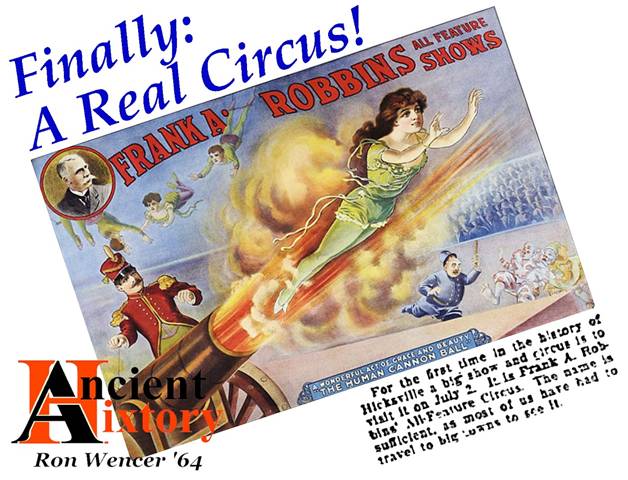
|
This
month, we're going to look at the traveling "Big Top" circus -
an immensely popular 19th century American innovation.
Big circuses would travel thousands of miles a year by rail,
bringing pageantry, excitement, and wonders to American towns.
Just before World War I, one finally came to
Hicksville
. Others - but not many
- would follow.
If you were an American who lived in the latter part of
the 1800s, you might awaken one day and see that circus posters now
dotted your town. About a
week later, the cars of a circus train could be seen in the local
freight yard when the sun rose. That
morning, there would be a parade; fancifully adorned horses would draw
elaborate wagons that were filled with exotic animals, clowns, and
musicians. Walking in the
parade would be many gaudy and equally exotic people.
The parade led townsfolk to what usually was an empty field, but
on that day it was filled with tents, including a large Big
Top.
|
Does
A Box of Animal Crackers Come To Mind?
|
|

|
|
The
Jester Band of Walter L. Main Shows, location unknown, parading
in 1921
thecircusblog.com
This
photograph could have been taken in
Hicksville
,
which was a stop on the Main Shows' tour that season.
|
|
*
|
Today's jaded audiences may not realize that circuses
long were considered top-tier entertainment, and not just in
North America
. In the latter 1800s,
American circuses had morphed, evolving into larger, glitzier, more
spectacular shows, featuring star performers from all over the world.
An indication of their popularity is that at the end of the 19th
century, the Barnum and Bailey
show went to
Europe
and toured there - for five years!
Obviously, the demand for circuses was great.
Apart from increased population, the chief factor that spurred
the growth of circuses was the rise of railroads.
Traditionally, circuses had traveled in caravans of horse-drawn wagons,
leaving their winter quarters each spring, and returning to them in the
autumn. Any given circus
could cover only so much ground each year, for it had to get back to its
winter quarters while it still had good weather in which to travel and
perform. Over the years,
when it was near its base, it had to visit the same towns many times -
and when it did, the audiences would be small.
The locals had already seen the show many times.
Traveling by train eliminated that problem.
A season's performances no longer had to start and end near the
winter quarters; each year, there could be different territories, with
fresh audiences. Moreover,
trains could transport longer tent poles and bigger sheets of canvas
than wagons could. That made
bigger tents and bigger crowds possible.
At each stop on a tour, living quarters and supply cars stayed in
the train yard, whereas they formerly had been part of the caravan's
parade of wagons. That meant
fewer wagons were needed for the parade to the circus grounds, which in
turn meant fewer horses, fewer harnesses and horseshoes, less feed to
buy, etc. Transporting a
circus by rail was easier and more economical.
Long Island
had plenty of railroad track and trains, but from the perspective of
most traveling circuses, it seemed out of reach: it had no rail
connection to the mainland. Thus,
in the 1880s, with no big circus on the Island, newspapers would report
that people traveled to Port Jefferson, from which they took the ferry
to
Bridgeport
to see a circus.
Of course, the
Island
was not truly beyond reach if a circus was determined to go there.
It was a matter of transporting the train and its contents -
animal, vegetable, and mineral - across
New York
Harbor
, or across the Sound. That
meant using freight car floats, barges on which railroad tracks had been
laid. These were already
used by a number of mainland railroads to move freight between
New Jersey
and, say,
Brooklyn
. One can imagine that this
approach worked better for smaller circuses than for big ones - the
latter used as many as seventy railroad cars.
|

|
|
Tug
with car float,
New York
Harbor
, c.1925
collections.mcny.org
|
|
*
|
The Ringling
Brothers circus made a tour stop in
Flushing
in 1891 (perhaps only part of it did; I do not know how much of the show
crossed the water). That
same season, two other well-known circuses came to the
Island
: the Frank A. Robbins' Shows
and the Walter L. Main Shows.
The latter performed at a dozen towns.
Incidentally, this was the first year that the Main
circus traveled by rail. The
year before, it had traveled over dirt roads from
Ohio
to
Massachusetts
and back, in a caravan of 120 horse-drawn wagons!
|

|
|
Potter
and Potter Auction Catalogue, 2017
|
|
***
|
|
1914: Robbins' Shows Comes
to
Hicksville
|
In
1913 and 1914, the Frank A.
Robbins' Shows circus again came to
Long Island
. In its more than 30 years,
it had developed a reputation for quality entertainment, and the people
of
Hicksville
were pleased that their town was a stop on the 1914 tour.
This circus seems to have struggled to survive for many years.
It filed for bankruptcy in 1897, and then again several years
later. A train wreck in 1910
made things more difficult, but it kept going.
In 1915, it would have to end its tour prematurely, as it ran out
of money, but it would return the following year.
The word "shows" - plural - in its name referred to its
being affiliated with a separate touring Wild West show; the common
owner could try to juggle profits in order to keep both shows going.
In recent years, the circus had been contracting.
Its new advertising stressed that it was "complete" or
"high class," neither of which meant "large."
Its Big Top had been
built to accommodate three rings, but lately the circus had slimmed down
to two rings, and a review of the 1914 tour (shown further below in its
entirety) described it as a one-ring circus.
Of course, the smaller size made traveling easier, especially if
there were bodies of water to be crossed.
|
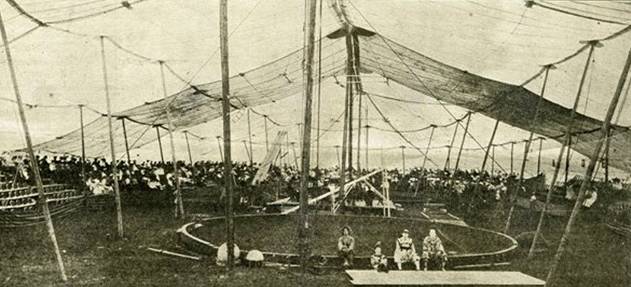
|
|
Clowns
pose on empty ring in Robbins' Shows'
red-and-white striped Big Top, c.1907
circustents.blogspot.com
|
For
the 1914 tour, it crossed the Sound following a performance in
Port Chester
,
NY
on a Saturday, and it next performed in
Port Washington
on a Monday. About two weeks
later, it would leave Long Island after performing at Bay Shore, sail
(or float) to who-knows-where, and take its train to
Ellenville
,
NY
for a Monday performance.
|
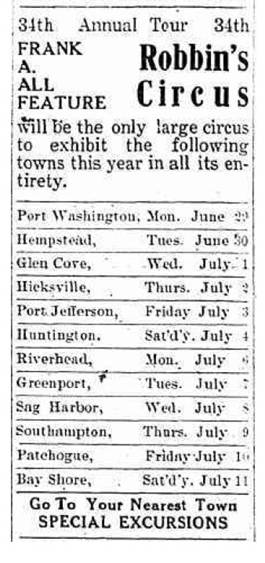
|
|
Huntington
Long-Islander, June 19, 1914
|
|
*
|
The
circus's "advance man" would have arrived on the Island while the
show was still playing in
Westchester
. As always, he then would
have traveled the tour route ahead of time, placing ads in local
newspapers, and plastering nearby towns with advertising material.
He had to inspect the fields he had booked, and confirm the
bookings for, or make alternate arrangements for, circus grounds.
He would deal with local suppliers re arrangements for food and
beverages, animal feed, and other supplies.
|

|
|
Hempstead
Sentinel, June 25, 1914
|
|
*
|
Thanks
to the advance man, newspapers carried "canned" descriptions of the
circus, which gave prospective attendees an idea of what to expect.
|

Hempstead
Sentinel, June 25, 1914?
|

|
|
|
Huntington
Long-Islander, June 19, 1914
|
A
few weeks before the circus arrived in Hicksville, the
Hudson
,
NY
, Evening Register published
the following independent review of what 1914's circus offered.
|

|
|
Hudson
NY Evening Register, June 5, 1914
Incidentally,
the fellow who slid down the wire on his head
performed under the name "Daredevil Devoe."
|
On
the same page were two related news stories; they convey what it meant
to small-town
America
to have a big circus come to town. The
first describes how a number of
Hudson
residents waited at the Boston and
Albany Railroad yard for the 5:00 AM (!) arrival of the circus
train, so that they could watch the circus animals be unloaded.
The second news story described the chaos that resulted when the
town's school children were dismissed just before noon to watch the
circus parade, which was about to pass nearby.
They pushed and shoved, all trying to run out of the building at
once; those who fell were trampled by others, who then fell, and got
similarly trampled.
One
can imagine how excited
Hicksville
's children were about the town's first experience with a well-known
circus.
|
***
|
|
1917: A
Railroad
Bridge
to the Mainland
|
In
1917, construction was completed on a railroad bridge over the waters of
the Hell Gate; it gave
Long Island
its first direct rail access to mainland railroads.
No, the project was not undertaken to make it easier for circuses
to connect to the LIRR and
visit
Nassau
and
Suffolk
- but it accomplished just that.
|
***
|
|
1921: Walter L. Main Shows
|
Just
where in
Hicksville
would circuses pitch their tents? Surprisingly,
the location for the 1914 circus visit seems to not have been published
in the newspapers.
In 1921, however, the Long-Islander
told its readers that on the Friday before Memorial Day, the Walter
L. Main Shows would perform "on the Plains on
Jerusalem Avenue
." Looking at old maps
does not help much, other than indicating that around that time, there
were plenty of open fields south of Old Country Road, including the one
on which the town's first High School building would be constructed a
few years later.
|

|
|
Huntington
Long-Islander, June 19, 1914
|
|

|
|
Ornate
horse-drawn wagon with steam-powered
calliope, used by Walter L. Main Shows in 1921
circushistory.org/archive
|
The
parade likely assembled on
Barclay Street
, near the LIRR yard to the west of the
Hicksville
station. It would have
headed east, and then turned south onto
Jerusalem Avenue
, continuing until it reached the circus grounds.
The piercing but melodic sound of a calliope may never have been
heard before in
Hicksville
; it was a sure way of getting the whole town's attention.
The
Hell Gate
Bridge
was far from the minds of Hicksvillians, but they felt its impact
anyway. This was an entire
three-ring circus, with an abundance of animal acts, and nothing had had
to be left out in order to get it over to
Long Island
. The circus train would
have crossed over the water into
Astoria
in only a few minutes, and not many hours later, the parade at the first
L.I. tour stop would have been underway.
Seeing the performance in your own town would have been amazing.
There was a lion trained to ride on a horse - and a horse
trained not to be spooked when a lion pounced on its back.
There were bears that danced, balanced on large balls, and
feigned drunkenness. The
Wirth family, horse-borne acrobats who rode bareback, had begun with the
Ringling Brothers circus and
then gone independent. They
had recently concluded a well-received run at
New York
's famous Palace Theatre, and then joined the Main
circus to tour for the season.
|

|
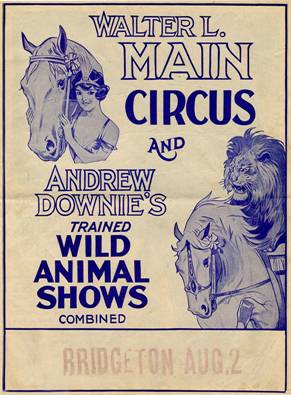
|
|
Potter
and Potter Auction Catalogue, 2017
|
thecircusblog.com
|
|

|
|
Potter
and Potter Auction Catalogue, 2020
|
|
***
|
|
The Next Decades
|
I
think that by now, we have a good idea of what old-time circuses were
like (that is, they were not much different from later circuses).
We also have some idea of how people in a rural town - which is
what Hicksville more or less was until the 1920s, even if
New York City
was not far away - felt in those years when a big circus came to their
hometown for a rare visit.
Things would change in the 1930s, for several reasons.
One was the Great Depression.
Another was the building of paved roads in rural areas, a
phenomenon prompted by another new reality: the widespread availability
of reliable automobiles and trucks.
It would still be a long time before big circuses considered
forsaking their trains, but Long Islanders began to see small circuses
or carnivals drive into nearby towns almost every summer.
A lion, or maybe a leopard (not a performing animal, but only a
poor beast, always caged for exhibiting), would arrive in town on the
back of a truck, along with other trucks that carried kiddy rides, some
midway games, and a trained horse act or acrobats.
It was difficult for circuses to tour during the Depression, but some
tried. Especially in smaller
towns, they might arrive and discover that a carnival had just spent a
couple of days there, leaving behind almost no one with enough money to
spend on circus tickets and souvenirs.
During World War II, strict rationing of fuel and tires, and government
control of manufacturing and rail transportation, brought new
challenges. Surprisingly,
because many prominent and influential people were circus fans, Ringling
Brothers and Barnum & Bailey was granted exemptions, supposedly
issued by the President's (i.e., FDR's) office.
The reason for the exemptions was that continuing the circus was
expected to help sustain public morale.
And so, the big circus kept touring.
Ironically, although encouraged to tour by one branch of the government,
another branch reportedly denied RBB&B
access to the fire-proofing chemicals that it normally applied to its
9,000 seat Big Top.
In 1944, when the un-fireproofed tent ignited during a
performance in
Hartford
, fire spread quickly. About
700 people were injured, and more than 160 people died.
|

|
|
Hartford
Courant photo
https://www.courant.com/opinion/
|
|
***
|
|
1950s: Ringling Bros. and Barnum & Bailey
|
To
my knowledge, none of the largest circuses pulled their circus trains
into
Hicksville
and performed there between 1921 and 1951.
If I am wrong, I'll be happy to be corrected.
After the war, circuses again enjoyed great popularity - not just with
working people, but also with the wealthy and the famous.
Newspapers regularly showed international celebrities attending
American circuses (e.g., the Duke of Windsor and his American Duchess,
Wallis Simpson). Actors and
comedians frequently got to perform in them, especially for charity
performances.
|

|
|
Ms
Monroe at
Madison
Square
Garden
c.1950 in the Ringling
Brothers and Barnum & Bailey Circus.
The elephant and its
harness were dyed pink to match her costume.
NewYorkSocialDiary.com
|
|
*
|
RBB&B
included
Hicksville
in its 1951 tour. To put
this in context, and to appreciate the magnitude of the 1951 version of
this circus, let's consider some statistics.
That year, the circus performed at 121 locations, gave 333
performances under canvas, and traveled more than 17,000 miles, from
Boston to Seattle to Baton Rouge, and then across the south to its
Florida home. At each stop,
it needed 15 empty acres on which to erect its 41 tents.
There were more than 1,200 employees in the tour, and almost
1,100 animals.
The circus train's 70 cars (together, more than 1.1 miles long) were
of course parked in the rail yard south of
Barclay Street
; the performance was held in an open field further west, on
John Street
.
|
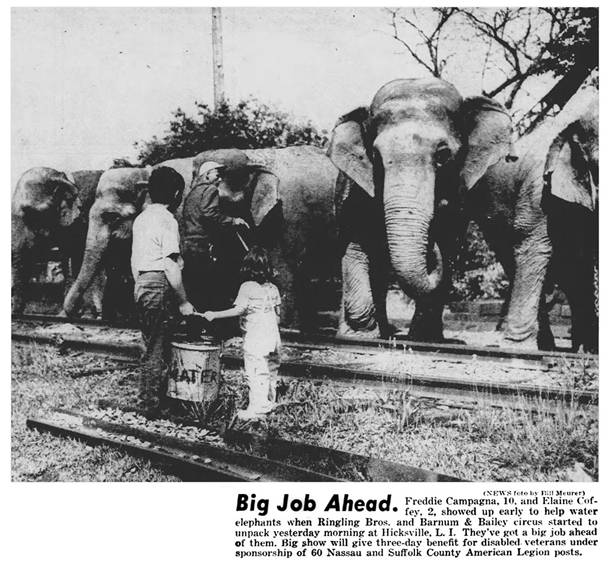
|
|
New York
Daily News, June 8, 1951
|
As
the caption above indicates, the three-day stop in Hicksville was one of
RBB&B's numerous
charitable performances, in this case coordinated with
Long Island
's American Legion posts.
The conveniently nearby site used for the circus grounds was not
going to be available for long. In
fact, it should not have been available at all.
Hicksville
developer Jerry Spiegel had intended to build new homes on it, but there
had been a recent government change in funding GI mortgages, and he had
stopped building homes in protest. Thus,
he was able to "donate" the use of land (which he was not using
anyway) to the fund-raising effort.
At this point, the reader probably does not need a description of more
circus acts. I shall instead
note that the 1952 film The
Greatest Show on Earth was shot during the early part of this
circus's 1951 tour; thus, the non-actor performers who appear in the
film are the actual workers and performers whom people saw on the 1951
tour. Incidentally, Greatest
was the top-grossing Paramount film of all time, as well as the
top-grossing film of the year, and it won 1952's Best Picture Oscar
for Cecil B. deMille.
|
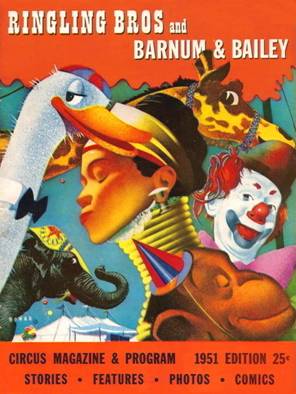
|

|
|
1951
RBB&B Circus Program cover
"Giraffe-Necked
Women from
Burma
"
were sideshow attractions for many
years. The Kayan
people of
Burma
still use progressively taller coils of
brass to gradually deform the clavicles
of growing girls, thus shortening their
ribcages to make their necks look longer.
ebay.com
|
James
Stewart, Cornel Wilde, and Charlton
Heston in The Greatest Show on Earth; one
never sees Stewart
without clown makeup
during the film
Note:
The film is in color; this must be a
publicity photo intended for newspapers.
Wikimedia.org
|
|
*
|
Five
years later, the 1956 version of the same circus performed in
Hicksville
. Externally, things may
have looked much the same, but they were very different.
Hicksville
had changed; choice temporary circus grounds were scarce.
RBB&B performed for two days on a field at Old Country and South
Oyster Bay Roads. More
important, the circus was wrestling with serious labor disruptions, and
it was in the process of laying off a number of "offstage" workers.
Whether or not the layoffs were to blame is debatable, but something
went wrong.
|
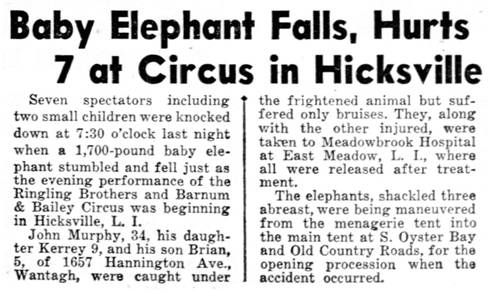
|
|
New York
Daily News, June 14, 1956
|
The
Times reported that all the
injuries were minor contusions, and that the cause of the accident was
the young elephant's tripping over some hard-to-see safety netting
that lay in its path. As
with other such incidents, people later tended to recall this mishap in
somewhat inflated terms, especially if they were children at the time.
The
labor issues were the result of the circus owners' intentions to cut
costs long-term. Among their
options, they considered switching the circus from its train to highway
travel, a change which would have affected literally everyone in the
circus. Ultimately, that
idea was dropped, because it would not have been cost-effective.
On the other hand, RBB&B
did decide to do away with its tents - after 1956, its tour would stop
only in arenas. This change
would be drastic, but it was understandable.
In 1951, the circus had played only at three indoor venues (
Madison
Square
Garden
,
Boston
Garden
, and the
San Francisco
Cow
Palace
). The rest of the time
- 79% of the year's performances - the Big
Top was in a country town, or on the undeveloped edge of city in a
rural region. By 1956,
suburbia was becoming well established in that kind of territory, and it
was getting difficult to find convenient 15-acre lots.
From the owners' viewpoint, the circus would draw just as many
people by playing in arenas built for sports as it would in Big
Tops.
Of course, there would be a significant impact on the other stakeholders
- the audiences and the employees.
The "circus experience" would be very different.
Rural townsfolk would no longer have the excitement of seeing the
circus train arrive, and watching the parade (although the performance
in the arena would feature an indoor parade, to be viewed from a
distance, not from curbside). Driving
some miles to an arena might be all right, but enduring traffic jams,
and finding parking spots, were not part of the old circus experience.
Besides, when people attended a circus in an arena, they
wouldn't be sharing the experience with the rest of their hometown and
with their extended family. The
circus would no longer feel like a shared personal or community
experience.
For
employees, the change would be even more disruptive.
It would affect livelihoods.
Someone who'd spent a couple of decades, say, expertly erecting
the Big Top, or inspecting it
for damage and making repairs by hand, and whose living quarters were
provided by his employer, was not likely to find himself qualified for a
different job that offered comparable benefits.
And what about circus families?
A hypothetical equestrian performer whose husband had worked in a
tent crew now faced a crisis. Would
the circus still house her family on the train, including her unemployed
husband, or would he have to settle somewhere with the children while
she traveled, and be a homemaker and father, living in a home they might
not be able to afford?
|

|
|
Legendary
RBB&B clown Emmett Kelly, and his wife read the news
reports of the circus's unexpectedly ending its season
prematurely,
and also announcing that its Big Top would be no more.
Years
later, their son Emmett Jr. would try starting his own circus.
NewYorkSocialDiary.com
|
For
reasons not necessarily clear, layoffs began during the tour.
Perhaps it was a question of the circus's "getting rid of
[perceived] troublemakers," or maybe it was a decision to economize
(e.g., because long-term tent maintenance was no longer needed, fewer
employees were required). Either
way, the layoffs exacerbated the unrest.
Things apparently boiled over only a month after the circus left
Hicksville
. On July 16, 1956, during
its scheduled stop at
Pittsburgh
, Ringling Brothers and Barnum & Bailey decided to end its season
prematurely. Its Big Top days were over.
Although
this biggest of American circuses would thrive for another half-century
and more, its efforts to remain relevant in a changing society
ultimately failed. It never
again performed in
Hicksville
, of course. When its time
came, it died a mere six miles away.
|

|
|
Old
friends, out for a nice stroll
NewYorkSocialDiary.com
|
|
***
|
|
Wrap-Up
|
I
never was a rabid circus fan, but I usually enjoyed attending a circus.
As a child, I saw the RBB&B
circus a few times at the old
Madison
Square
Garden
. Although many parts of each
performance were impressive, the most memorable aspect for me was the
hour before the show. My
father and I spent that time down in the menagerie, where I fed peanuts,
one by one, to the elephants. I
have never forgotten the touch of the elephants' trunks.
They moved lightly over my extended palm, grasped the peanuts,
lifted the peanuts to their mouths, and then gently returned, to search
my palm for more. I would
have been content to skip the circus itself, and instead spend all of my
Saturday afternoon that way. I
wondered why the circus didn't sell menagerie-only tickets.
My wife and I attended performances of later incarnations of the same
circus, in MSG, and still
later, in
Buffalo
and
Toronto
with our sons, and gradually I felt different about it.
Much of it was still excellent, especially the clowns.
But it seemed as if RBB&B
thought that its circus talent lineup was insufficient, that the acts
alone were not worth the price of an admission.
It was as if the circus had to concoct something artificial to
supplement the show's real talent.
Truly difficult feats, like doing multiple somersaults in the air
between trapezes, or having three motorcycle riders speed in different
directions inside a spherical cage, were needlessly offset by prolonged,
vapid spectacles.
Granted, circuses are inherently prone to excess, and they probably
always have tried to augment their talent with rather chintzy eye candy.
Shortly after World War II, however, John Ringling North, who
then ran RBB&B, hired
about sixty chorus girls, who became the core of the circus's new
"aerial ballet" galas. Years
later, when I saw the circus as an adult, there were bigger galas, with
still more showgirls, all doing the one, simple "trick" they had
been taught. Each of them
had to hang from an ankle-hold on a rope, resting the sole of her other
foot against the rope, while people on the ground anchored the ropes and
slowly moved them in unison.
|
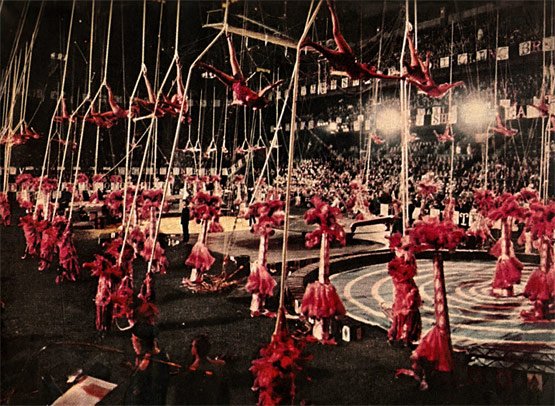
|
|
Aerial
Ballet of Ringling Brothers and Barnum & Bailey Circus,
Madison
Square
Garden
, 1950s
NewYorkSocialDiary.com
|
For
one professional performer to do this, and basically only this, would
not be very interesting or remarkable.
When sixty, or eighty, or more, do it at once, audiences
instinctively applaud. Presumably,
that's a response to the unison, which is due largely to the identical
costumes, and to the movements of the guys holding the ropes.
There's not an abundance of skill involved.
As you can tell, I am not a fan of spectacle-centric circuses.
No, I'd rather look back to one evening in
Hicksville
, some time around 1959, when a small, truck-transported circus - its
name is now forgotten - performed before a small audience in a tent on
North Broadway, where the Sears
later would be built.
The tent probably could hold only several hundred people.
It was as dark as a movie theatre, with spotlights aimed at the
one ring. If I had known the
word back then, I might have said that it was intime.
Even if you sat in the last row, you were close to the ring.
The animals and performers probably did nothing unique, but as I
remember it, whatever they attempted, they did well.
It was fun. After the
show, on the way out, I realized that everything smelled special.
Looking back, I think that that performance, with no glitz or grand
production numbers, left one with a feeling that was as close as
possible to what every circus should impart.
As
always, the sources listed beneath the images above are a good
indication of where I found information.
I discovered most of it by using the tried and true duo of Google and digitized old newspapers.
I also looked for images in the online offerings of the Library
of Congress, New York State,
and the Museum of the City of New
York.
Beware, the Internet is always changing.
While putting together this article, two of the sources that I
used became (only temporarily, I hope) unavailable.
To anyone interested in learning more about in the 1944 Hartford
disaster, I would recommend Stuart O'Nan's The
Circus Fire. There also
have been many, many other books, as well as articles and television
documentaries about the incident. The
event occurred before I was born, but I do have a personal connection to
it. My father's aunt
Katherine, and her granddaughter Valerie, 8, my second cousin, died
huddled together in the Big Top
that day.
If this article has motivated any readers to watch The Greatest Show on Earth, I owe those people a few words of
caution. It is not as good a
movie as its winning an Oscar
may suggest, and today it seems dated.
It remains of interest primarily as a vehicle for understanding
the era in which it was made, and the reverence which the nation once
had for the circus.
|
*****
|
|
Well, that's it.
I Hope You All Have a Better 2021!
|
|























